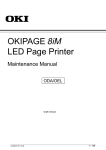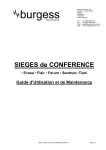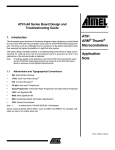Download CAMELIA 4M Digital Camera
Transcript
Main Features • • • • • • • • • High Sensitivity Full Frame CCD Sensor 2048 x 2048 Resolution with 14 µm Square Pixels 100% Aperture Pixels 12-bit Dynamic Range Very Low Noise: 66 dB SNR Binning Modes LVDS Data Format High Data Rate: 20 Mpixels/s Flexible and Easy to Operate via RS-232 Control – Trigger Mode: Free Run or External Trigger Modes – Binning 2 x 2 and 4 x 4 – Exposure Time – Gain: x1 to x8 – 3-Shot Color Operation • Single Power Supply: DC 24V • High Reliability – CE Compliant • F (Nikon) Mount Adapter (Lens Not Supplied) Product Description CAMELIA 4M Full Frame Black and White and 3-Shot Color Digital Camera This camera is designed to meet high performance and quality requirements while providing ease of use. • ATMEL manages the entire manufacturing process, from the sensor to the camera. The result is a camera that works in 12 bits, with dedicated electronics that provide an excellent signal to noise ratio. • The sensitivity of the camera is fairly high even in the near infrared spectrum thanks to the 100% aperture pixel. • The programmable settings let the user work at different integration times and gains. The external trigger enables synchronization of the camera on an external event, while the 3-shot color mode allows very high resolution for color image acquisition. Applications Performance and reliability of this camera make it well suited for the most demanding applications such as film and document scanning, semiconductor and PCB inspection, DNA analysis, metrology or X-ray imaging. Rev. 5301C–IMAGE–03/04 1 Camelia Package Contents System Requirements Depending on the selected configuration, a Camelia package may include: • Camelia camera • FGT frame grabber board • Power supply cable and RS-232 cable • Data and sync cable • COMMCAM software • FGT software • Documentation • 24V (0.6A) power supply • Computer: – Minimal configuration: Intel® Pentium® II 350 MHz RAM: 128 Mb, 256 Mb for 3-shot color mode Cache memory: 256 Kb 1 free PCI slot – Operating system: Windows® NT 4.0 Windows® 95b, 98 Getting Started • NIKON lens • Lighting control (shutter/chopper or pulsed lighting) 1. Connect the camera to one of the computer’s serial ports (COM1 or COM2) with the RS-232 cable. 2. Switch on the camera. 3. Install the COMMCAM software on your computer (refer to the “COMMCAM User Guide”). 4. Install the FGT frame grabber board and the FGT software on your computer (see the “FGT Frame Grabber User Guide”). 5. Run the system. 2 CAMELIA 4M Digital Camera 5301C–IMAGE–03/04 CAMELIA 4M Digital Camera Description of Imaging System Figure 1. Imaging System FGT Frame Grabber Control Box Light Source Light & Shutter Trigger Cables Data & Sync Cable RS-232 Cable Computer Lens Shutter & BG38 Power Supply Cable Camera 24V The Camelia 4M is powered by a 24V power supply and is configured through the serial port of the computer. The camera sends digital video to the FGT frame grabber. As the Camelia's CCD is a full frame sensor, either pulsed lighting or a chopper/shutter must be used in front of the camera during the integration time in order to obtain incident lighting on the CCD. The user must design an electro-optical interface to drive the camera, shutter/chopper or lighting by using the SHUTTER signal delivered by the camera. If required, the system can send an external trigger or external ITC (integration time control) signal to the camera. 3 5301C–IMAGE–03/04 Camelia 4M Camera CCD Description • Image format: 28.7 mm (V) x 28.7 mm (H) • 2048 mm (V) x 2048 mm (H) active pixels • Readout register along the small side of the image area (vertical image) • Pixel geometry: • Timing – 14 µm (V) x 14 µm (H) – 100% aperture ratio Antiblooming by clocking 2 x 2 and 4 x 4 pixel binning can be used to enable previewing modes. Data rate (pixel clock): 20 MHz Table 1. Frame Readout Times Mode Frame Readout Times No binning 235 ms 2 x 2 pixel binning 125 ms 4 x 4 pixel binning 70 ms Three timing modes are available: Continuous Timing Mode • Continuous • External triggered • Integration time controlled (ITC) The camera delivers frames continuously: • Frame N+1 integration starts as soon as frame N readout is completed. • The integration time is set by the RS-232 interface. Figure 2. Continuous Timing Diagram Frame integration Shutter delay Frame readout Int. time set by RS-232 2 ms 2048 pixels 2048 2047 2046 3 2 Video lines 1 LEN FEN SHUTTER 4 CAMELIA 4M Digital Camera 5301C–IMAGE–03/04 CAMELIA 4M Digital Camera External Trigger Timing Mode The external TRIG signal allows the user to control the start of frame integration: • The rising edge of TRIG activates the start of frame integration. This rising edge is synchronized by the camera with a precision of 112 µs. • The integration time is set by the RS-232 interface. • Note that the TRIG signal period must be greater than the sum of the integration time and the frame readout time. Figure 3. External Trigger Timing Diagram Frame integration Shutter delay Frame readout Waiting Int. time set by RS-232 TRIG 2048 pixels 2047 2048 2046 3 Video lines 1 2 LEN FEN SHUTTER Integration Time Control (ITC) Timing Mode The external ITC signal allows the user to fully control the frame integration: • The falling edge of ITC activates the start of frame integration. This falling edge is synchronized by the camera with a precision of 112 µs. • The rising edge of ITC activates the stop of frame integration. This rising edge is synchronized by the camera with a precision of 112 µs. • Note that the ITC signal period must be greater than the sum of the integration time (defined by ITC low) and the frame readout time. Figure 4. Integration Time Control Timing Diagram Frame integration Shutter delay Frame readout Waiting ITC 2048 pixels 2047 2048 2046 3 Video lines 1 2 LEN FEN SHUTTER Antiblooming by Clocking Antiblooming can be activated or inhibited (see “RS-232 Interface” on page 8): • Antiblooming OFF: antiblooming inhibited. Recommended if antiblooming is not required for the application. • Antiblooming ON: antiblooming activated. 5 5301C–IMAGE–03/04 3-Shot Color Modes In 3-shot color mode, each image is made of three frames: red, green and blue. • The camera must be operated in either external trigger mode or integration time control mode. • For each image, the user selects the color of the next frame by setting the input signals COLOUR_I1 and COLOUR_I2 (see Table 2). COLOUR_I1, _I2 must be valid between the rising edge of the TRIG signal (or the falling edge of the ITC signal) and the falling edge of the SHUTTER signal (see Figure 5). Table 2. Color definition COLOUR_I2 COLOUR_I1 Frame Color 0 0 Red 0 1 Green 1 0 Blue • The integration time can be adjusted differently for each color, resulting in a better signal to noise ratio for the color with the lowest sensitivity (i.e the blue). • Each frame requires a TRIG_ITC signal. • The camera synchronizes COLOUR_I1, _I2 with the rest of the timing and sends COLOUR_O1, _O2 to the FGT frame grabber. Figure 5. Color Timing Diagram Red integration time Green integration time Blue integration time TRIG 00 COLOUR_I >0 01 >0 >0 10 >0 >0 >0 SHUTTER FEN COLOUR_O 00 Frame 00 (red) 01 10 Frame 01 (green) Frame 10 (blue) Electrical Interfaces Power Supply Table 3. Power Supply Specifications Parameter 6 Nominal Value Min Value Max Value Voltage 24V 20V 28V Current 0.75A N/A N/A CAMELIA 4M Digital Camera 5301C–IMAGE–03/04 CAMELIA 4M Digital Camera Digital I/O Table 4. Digital I/O Specifications Symbol I/O Definition Level TRIG_ITC I Timing control: - TRIG_ITC is either an external trigger or ITC (integration time control) depending on the timing mode configured via RS-232. Operation with external trigger: - TRIG_ITC = TRIG Operation with ITC: - TRIG_ITC = ITC - TRIG_ITC is synchronized by the camera line clock (jitter: 112 µs) S(11..0) O Digital video output: 12 bits LVDS FEN O Frame enable: - FEN = 0: frame data valid: active lines - FEN = 1: frame data not valid LVDS LEN O Line enable: - LEN = 0: line data valid: active pixels - LEN = 1: line data not valid LVDS PCK O Pixel clock LVDS O Shutter open/close: - during integration: SHUTTER = 1 - during readout: SHUTTER = 0 Delay between the falling edge of SHUTTER and the start of readout: - 4 positions: 1, 5, 10 or 20 ms (set via RS-232). LVDS I Color selection of the next frame (in color mode): - 00: red - 01: green - 10: blue LVDS O Color identification of the current frame (in color mode): - 00: red - 01: green - 10: blue. LVDS SHUTTER COLOUR_I(1..0) COLOUR_O(1..0) Note: LVDS(1) 1. LVDS (Low Voltage Differential Signal) is an EI- 644 standard. LVDS drivers/receivers: • LVDS: all digital I/Os are differential: (signal+, signal-). Specifications are given for signal +. • Manufacturer National Semiconductor®. • Driver: DS90C031TM (SO16 package) • Receiver: DS90C032TM (SO16 package). 7 5301C–IMAGE–03/04 RS-232 Interface The camera’s configuration is set by the RS-232 interface. Table 5 lists the available features: Table 5. RS-232 Specifications Function RS-232 Configuration Timing mode 3 modes: - continuous (free running) - external trigger - external ITC Binning 3 modes: - no binning - 2 x 2 pixel binning - 4 x 4 pixel binning Image size: 2048 (H) x 2048 (V) Image size: 1024 (H) x 1024 (V) Image size: 512 (H) x 512 (V) CDS gain(1) 2 positions: -G=1 -G=4 G = 4 is recommended for applications requiring high sensitivity Camera gain(1) Camera gain value from 1.00x to 2.00x in 16 steps Shutter 2 modes: - active - inactive (always open) Shutter delay 4 positions: - 1 ms - 5 ms - 10 ms - 20 ms Antiblooming control 2 modes: - active - inactive Black and white/ color mode 2 modes: - black and white - 3-shot color Black and white integration time Value must be in milliseconds Range: 1 to 2000 ms; active only in black and white mode Red/Green/Blue integration time Value must be in milliseconds Range: 1 to 2000 ms; active only in 3-shot color mode Note: Comment Must be an integer (e.g. 120 for 120 ms, 120.4 is not permitted) Must be an integer (e.g. 120 for 120 ms, 120.4 is not permitted) 1. The video signal processing gain of the camera can be adjusted by setting either the CDS or camera gain. CDS gain: a 1x or 4x gain is available at the input of the video signal processing. Use of the 4x gain is recommended for low level applications as it results in lower noise. Camera gain: a range of 1x to 2x is available in 16 steps. 8 CAMELIA 4M Digital Camera 5301C–IMAGE–03/04 CAMELIA 4M Digital Camera Electro-optical Performance Conditions: • Frame integration time: 40 ms • Operating ambient temperature: 25° C Table 6. Electro-optical Performance Symbol Typical Value Unit VPE 4095 LSB(1) VN 2 LSB DSNU 5 LSB DY 2048 – R 35 LSB/(nJ/cm2) Resolution(7) Horizontal Contrast Transfer function at Nyquist CTFh 40% – Vertical Contrast Transfer function at Nyquist CTFv 40% – Parameter Full-scale value(2) Temporal noise(3) (4) Dark signal non-uniformity Dynamic range (5) Responsivity(6) Notes: 1. LSB (Least Significant Bit): 12-bit = 4095 LSB or gray levels 2. Full-scale value VPE: maximum digital video signal 3. Temporal noise VN: r.m.s value in darkness; measured by subtracting two images pixel to pixel 4. Dark signal non uniformity: r.m.s value; excludes blemishes 5. Dynamic range DY = VPE/VN 6. Responsivity conditions: CDS gain = 1x, 3200K, light source powered between 300 and 1000 nm, measured on the sensor 7. Resolution conditions: light source 3200K, BG38 2 mm, measured at VIDEO = 2000 LSB, CDS gain = 1x Figure 6. Camelia 4M Spectral Responsivity Responsivity (LSB/nJ/cm2) 60 40 20 0 400 450 500 550 600 650 700 750 Wavelength (nm) 800 850 900 950 1000 Note: nJ/cm2 measured on the CCD chip. 9 5301C–IMAGE–03/04 Image Grade Operating conditions Definitions • Room temperature: 20° C • Integration time in darkness: 100 ms • Light source: Halogen 3200K with BG38 (2 mm thick) IR cut-off with f/4 aperture • Test under illumination at 50% saturation level A column defect is a one-pixel-wide column with more than 7 defective pixels. The column's height is constant with the light level. Z1 is a square area whose size is 0.5 (H) x 0.5 (V) [1024 pixels (H), 1024 pixels (V)] centered in the image zone. Z2 corresponds to the rest of the image zone. α is the contrast of the defect measured as a percentage under light and in ADU in darkness. ADU: 12 bits correspond to 4096 ADUs. Table 7. Specifications in Darkness Type Z1 Blemish threshold Z1 + Z2 White defects in darkness Defects at 50% VSAT White defects in darkness Defects at 50% VSAT α > 80 ADU [α] > 20% α > 80 ADU [ α] > 20% Maximum number of pixels affected by blemishes 600 2000 Area maximum (in pixels) 5x5 5x5 Column threshold Maximum number of column defects 10 α > 5 ADU [α] > 10% α > 5 ADU [α] > 10% 3 10 10 40 CAMELIA 4M Digital Camera 5301C–IMAGE–03/04 CAMELIA 4M Digital Camera Geometrical Specifications Figure 7. Camelia 4M Geometrical Specifications Front Panel 4 x M3 (depth 6.0 mm) 74.0 mm 4.0 mm 6.0 mm 64.0 mm 2 x ∅ 2.0 mm 25.6 mm 2 x 1/4_20 UNC 2B ∅ 66.0 mm 64.0 mm 108.0 mm 114.0 mm 144.5 mm 112.0 mm Rear Panel Data & Sync CAMELIA 4M SN: Made in France RS 232 Power 110.5 mm Weight: 1.4 kg Environmental Requirements • Operating temperature: 0 to 50° C • Storage temperature: -20 to 70° C • Operating humidity: < 80% at 35° C • Vibration: 2g sinusoidal, from 10 to 100 Hz 11 5301C–IMAGE–03/04 Connectors and Cables Data and Sync Connector 50 points 3M connector: • Connector reference: HIROSE DX10A-50S • Mating connector on cable side: HIROSE DX40-50P; shell: HIROSE DX50-CV1 Table 8. Data and Sync Cable(3) Pinout Pin Number Signal Pin Number Signal 1 PCK+ 26 LEN+ 2 PCK- 27 LEN- 3 FEN+ 28 COLOUR_O1+(1) 4 FEN- 29 COLOUR_O1-(1) 5 COLOUR_O2+(1) 30 GROUND 6 (1) 31 GROUND Notes: 12 COLOUR_O2- 7 PDATA0+ 32 PDATA1+ 8 PDATA0- 33 PDATA1- 9 PDATA2+ 34 PDATA3+ 10 PDATA2- 35 PDATA3- 11 PDATA4+ 36 PDATA5+ 12 PDATA4- 37 PDATA5- 13 PDATA6+ 38 PDATA7+ 14 PDATA6- 39 PDATA7- 15 PDATA8+ 40 PDATA9+ 16 PDATA8- 41 PDATA9- 17 PDATA10+ 42 PDATA11+ 18 PDATA10- 43 PDATA11- 19 GROUND 44 NC(2) 20 GROUND 45 NC(2) 21 SHUTTER+ 46 TRIG_ITC+ 22 SHUTTER- 47 TRIG_ITC- 23 (1) COLOUR_I1+ 48 COLOUR_I2+(1) 24 COLOUR_I1-(1) 49 COLOUR_I2-(1) 25 NC 50 NC 1. Not used, must be left unconnected. 2. NC: not connected. 3. A Data and Sync cable is provided with the FGT frame grabber. It includes a part that connects to the electro-optical interface, and to the FGT frame grabber. Refer to the “FGT Frame Grabber User Manual”. CAMELIA 4M Digital Camera 5301C–IMAGE–03/04 CAMELIA 4M Digital Camera Power Supply Cable Connector on supply side: SUBD9 male Table 9. Pinout Note: RS-232 Cable Pin Number Signal 1 24V 2 24V 3 NC 4 NC 5 NC 6 GROUND 7 GROUND 8 NC 9 NC NC: not connected Connector on computer side: • DSUB9 female, • Pinout compatible with a computer serial port. The pinout is the same on both the camera and computer sides. 13 5301C–IMAGE–03/04 Atmel Corporation 2325 Orchard Parkway San Jose, CA 95131, USA Tel: 1(408) 441-0311 Fax: 1(408) 487-2600 Regional Headquarters Europe Atmel Sarl Route des Arsenaux 41 Case Postale 80 CH-1705 Fribourg Switzerland Tel: (41) 26-426-5555 Fax: (41) 26-426-5500 Asia Room 1219 Chinachem Golden Plaza 77 Mody Road Tsimshatsui East Kowloon Hong Kong Tel: (852) 2721-9778 Fax: (852) 2722-1369 Japan 9F, Tonetsu Shinkawa Bldg. 1-24-8 Shinkawa Chuo-ku, Tokyo 104-0033 Japan Tel: (81) 3-3523-3551 Fax: (81) 3-3523-7581 Atmel Operations Memory 2325 Orchard Parkway San Jose, CA 95131, USA Tel: 1(408) 441-0311 Fax: 1(408) 436-4314 RF/Automotive Theresienstrasse 2 Postfach 3535 74025 Heilbronn, Germany Tel: (49) 71-31-67-0 Fax: (49) 71-31-67-2340 Microcontrollers 2325 Orchard Parkway San Jose, CA 95131, USA Tel: 1(408) 441-0311 Fax: 1(408) 436-4314 La Chantrerie BP 70602 44306 Nantes Cedex 3, France Tel: (33) 2-40-18-18-18 Fax: (33) 2-40-18-19-60 ASIC/ASSP/Smart Cards 1150 East Cheyenne Mtn. Blvd. Colorado Springs, CO 80906, USA Tel: 1(719) 576-3300 Fax: 1(719) 540-1759 Biometrics/Imaging/Hi-Rel MPU/ High Speed Converters/RF Datacom Avenue de Rochepleine BP 123 38521 Saint-Egreve Cedex, France Tel: (33) 4-76-58-30-00 Fax: (33) 4-76-58-34-80 Zone Industrielle 13106 Rousset Cedex, France Tel: (33) 4-42-53-60-00 Fax: (33) 4-42-53-60-01 1150 East Cheyenne Mtn. Blvd. Colorado Springs, CO 80906, USA Tel: 1(719) 576-3300 Fax: 1(719) 540-1759 Scottish Enterprise Technology Park Maxwell Building East Kilbride G75 0QR, Scotland Tel: (44) 1355-803-000 Fax: (44) 1355-242-743 Literature Requests www.atmel.com/literature Disclaimer: Atmel Corporation makes no warranty for the use of its products, other than those expressly contained in the Company’s standard warranty which is detailed in Atmel’s Terms and Conditions located on the Company’s web site. The Company assumes no responsibility for any errors which may appear in this document, reserves the right to change devices or specifications detailed herein at any time without notice, and does not make any commitment to update the information contained herein. No licenses to patents or other intellectual property of Atmel are granted by the Company in connection with the sale of Atmel products, expressly or by implication. Atmel’s products are not authorized for use as critical components in life support devices or systems. © Atmel Corporation 2004. All rights reserved. Atmel ® and combinations thereof, are the registered trademarks, and Camelia ™ is the trademark of Atmel Corporation or its subsidiaries. Windows ® is a registered trademark of Microsoft Corporation. Intel ® and Pentium ® are registered trademarks of Intel Corporation. National Semiconductor® is a registered trademark of National Semiconductor Corporation. Other terms and product names may be the trademarks of others. Printed on recycled paper. 5301C–IMAGE–03/04 0M



























